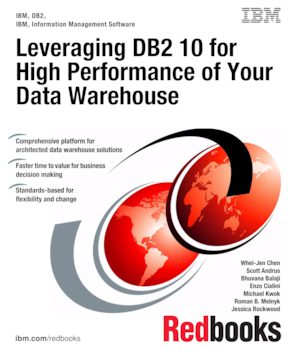About cookies on this site Our websites require some cookies to function properly (required). In addition, other cookies may be used with your consent to analyze site usage, improve the user experience and for advertising. For more information, please review your options. By visiting our website, you agree to our processing of information as described in IBM’sprivacy statement. To provide a smooth navigation, your cookie preferences will be shared across the IBM web domains listed here.

Published on 08 January 2014
Read in Google Books Order hardcopy
Share this page:
ISBN-10: 0738438979
ISBN-13: 9780738438979
IBM Form #: SG24-8157-00
Authors: Whei-Jen Chen, Scott Andrus, Bhuvana Balaji, Enzo Cialini, Michael Kwok, Roman B. Melnyk and Jessica Rockwood
Abstract
Building on the business intelligence (BI) framework and capabilities that are outlined in InfoSphere Warehouse: A Robust Infrastructure for Business Intelligence, SG24-7813, this IBM® Redbooks® publication focuses on the new business insight challenges that have arisen in the last few years and the new technologies in IBM DB2® 10 for Linux, UNIX, and Windows that provide powerful analytic capabilities to meet those challenges.
This book is organized in to two parts. The first part provides an overview of data warehouse infrastructure and DB2 Warehouse, and outlines the planning and design process for building your data warehouse. The second part covers the major technologies that are available in DB2 10 for Linux, UNIX, and Windows. We focus on functions that help you get the most value and performance from your data warehouse. These technologies include database partitioning, intrapartition parallelism, compression, multidimensional clustering, range (table) partitioning, data movement utilities, database monitoring interfaces, infrastructures for high availability, DB2 workload management, data mining, and relational OLAP capabilities. A chapter on BLU Acceleration gives you all of the details about this exciting DB2 10.5 innovation that simplifies and speeds up reporting and analytics. Easy to set up and self-optimizing, BLU Acceleration eliminates the need for indexes, aggregates, or time-consuming database tuning to achieve top performance and storage efficiency. No SQL or schema changes are required to take advantage of this breakthrough technology.
This book is primarily intended for use by IBM employees, IBM clients, and IBM Business Partners.
Table of Contents
Part 1. Overview
Chapter 1. Gaining business insight with IBM DB2
Chapter 2. Technical overview of IBM DB2 Warehouse
Chapter 3. Warehouse development lifecycle
Part 2. Technologies
Chapter 4. Column-organized data store with BLU Acceleration
Chapter 5. Row-based data store
Chapter 6. Data movement and transformation
Chapter 7. Monitoring
Chapter 8. High availability
Chapter 9. Workload management
Chapter 10. Mining and unstructured text analytics
Chapter 11. Providing the analytics